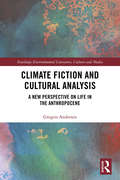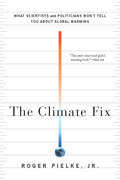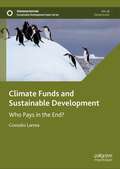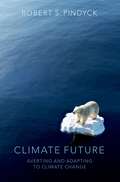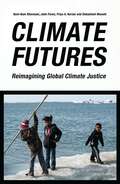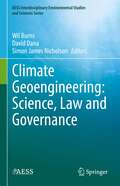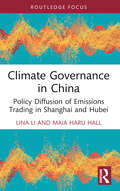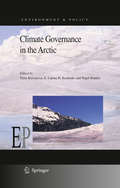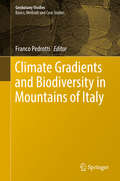- Table View
- List View
Climate Fiction and Cultural Analysis: A new perspective on life in the anthropocene (Routledge Environmental Literature, Culture and Media)
by Gregers AndersenClimate Fiction and Cultural Analysis argues that the popularity of the term "climate fiction" has paradoxically exhausted the term’s descriptive power and that it has developed into a black box containing all kinds of fictions which depict climatic events and has consequently lost its true significance. Aware of the prospect of ecological collapse as well as our apparent inability to avert it, we face geophysical changes of drastic proportions that severely challenge our ability to imagine the consequences. This book argues that this crisis of imagination can be partly relieved by climate fiction, which may help us comprehend the potential impact of the crisis we are facing. Strictly assigning "climate fiction" to fictions that incorporate the climatological paradigm of anthropogenic global warming into their plots, this book sets out to salvage the term’s speculative quality. It argues that climate fiction should be regarded as no less than a vital supplement to climate science, because climate fiction makes visible and conceivable future modes of existence within worlds not only deemed likely by science, but which are scientifically anticipated. Focusing primarily on English and German language fictions, Climate Fiction and Cultural Analysis shows how Western climate fiction sketches various affective and cognitive relations to the world in its utilization of a small number of recurring imaginaries, or imagination forms. This book will be of great interest to students and scholars of ecocriticism, the environmental humanities, and literary and culture studies more generally.
Climate Finance as an Instrument to Promote the Green Growth in Developing Countries (SpringerBriefs in Climate Studies)
by Antonio A. Romano Giuseppe Scandurra Alfonso Carfora Monica RonghiThis book analyses the effectiveness of climate finance as political instrument to reduce the effect of anthropogenic activities on climate change and promote the green growth in developing countries.The book highlights that close attention should also be paid to the analysis of political contexts in a broad sense. Particularly focusing on the international negotiations process that enables the direction of funds toward specific needs and priorities and the issue of access to electricity. For example, the difficulties that developing countries face when trying to improve their green economic development without access to carbon remains a matter of the utmost importance and urgency for many developing countries that lack significant aid from developed countries. This book will be of interest to a wide body of academics and practitioners in climate change and energy policies. Moreover, this project is a valid instrument for students in energy policies and climate programs.
Climate, Fire and Human Evolution: The Deep Time Dimensions of the Anthropocene (Modern Approaches in Solid Earth Sciences #10)
by Andrew Y. Glikson Colin GrovesThe book outlines principal milestones in the evolution of the atmosphere, oceans and biosphere during the last 4 million years in relation with the evolution from primates to the genus Homo – which uniquely mastered the ignition and transfer of fire. The advent of land plants since about 420 million years ago ensued in flammable carbon-rich biosphere interfaced with an oxygen-rich atmosphere. Born on a flammable Earth surface, under increasingly unstable climates descending from the warmer Pliocene into the deepest ice ages of the Pleistocene, human survival depended on both—biological adaptations and cultural evolution, mastering fire as a necessity. This allowed the genus to increase entropy in nature by orders of magnitude. Gathered around camp fires during long nights for hundreds of thousandth of years, captivated by the flickering life-like dance of the flames, humans developed imagination, insights, cravings, fears, premonitions of death and thereby aspiration for immortality, omniscience, omnipotence and the concept of god. Inherent in pantheism was the reverence of the Earth, its rocks and its living creatures, contrasted by the subsequent rise of monotheistic sky-god creeds which regard Earth as but a corridor to heaven. Once the climate stabilized in the early Holocene, since about ~7000 years-ago production of excess food by Neolithic civilization along the Great River Valleys has allowed human imagination and dreams to express themselves through the construction of monuments to immortality. Further to burning large part of the forests, the discovery of combustion and exhumation of carbon from the Earth’s hundreds of millions of years-old fossil biospheres set the stage for an anthropogenic oxidation event, affecting an abrupt shift in state of the atmosphere-ocean-cryosphere system. The consequent ongoing extinction equals the past five great mass extinctions of species—constituting a geological event horizon in the history of planet Earth.
The Climate Fix: What Scientists and Politicians Won't Tell You About Global Warming
by Roger Pielke Jr.Why has the world been unable to address global warming? Science policy expert Roger Pielke, Jr., says it's not the fault of those who reject the Kyoto Protocol, but those who support it, and the magical thinking that the agreement represents. In The Climate Fix, Pielke offers a way to repair climate policy, shifting the debate away from meaningless targets and toward a revolution in how the world's economy is powered, while de-fanging the venomous politics surrounding the crisis. The debate on global warming has lost none of its power to polarize and provoke in a haze of partisan vitriol. The Climate Fix will bring something new to the discussions: a commonsense perspective and practical actions better than any offered so far.
Climate Forcing of Geological Hazards
by Bill McGuire Mark MaslinClimate Forcing of Geological Hazards provides a valuable new insight into how climate change is able to influence, modulate and trigger geological and geomorphological phenomena, such as earthquakes, tsunamis, volcanic eruptions and landslides; ultimately increasing the risk of natural hazards in a warmer world. Taken together, the chapters build a panorama of a field of research that is only now becoming recognized as important in the context of the likely impacts and implications of anthropogenic climate change. The observations, analyses and interpretations presented in the volume reinforce the idea that a changing climate does not simply involve the atmosphere and hydrosphere, but also elicits potentially hazardous responses from the solid Earth, or geosphere. Climate Forcing of Geological Hazards is targeted particularly at academics, graduate students and professionals with an interest in environmental change and natural hazards. As such, we are hopeful that it will encourage further investigation of those mechanisms by which contemporary climate change may drive potentially hazardous geological and geomorphological activity, and of the future ramifications for society and economy.
Climate Forcing of Geological Hazards
by Bill McGuire Mark A. MaslinClimate Forcing of Geological Hazards provides a valuable new insight into how climate change is able to influence, modulate and trigger geological and geomorphological phenomena, such as earthquakes, tsunamis, volcanic eruptions and landslides; ultimately increasing the risk of natural hazards in a warmer world. Taken together, the chapters build a panorama of a field of research that is only now becoming recognized as important in the context of the likely impacts and implications of anthropogenic climate change. The observations, analyses and interpretations presented in the volume reinforce the idea that a changing climate does not simply involve the atmosphere and hydrosphere, but also elicits potentially hazardous responses from the solid Earth, or geosphere. Climate Forcing of Geological Hazards is targeted particularly at academics, graduate students and professionals with an interest in environmental change and natural hazards. As such, we are hopeful that it will encourage further investigation of those mechanisms by which contemporary climate change may drive potentially hazardous geological and geomorphological activity, and of the future ramifications for society and economy.
Climate Friendly Goods and Technologies in Asia: Opportunities For Trade (SpringerBriefs in Environmental Science)
by Soumyananda DindaThis book investigates the potential trade opportunity of climate friendly goods and technology (CFGT) in Asia and South Asia region, and uses a case study of India to clarify India's position on global warming and efforts to mitigate climate change impacts regionally and globally. In four main sections, the book applies econometric techniques to analyze the trade performance of CFGTs in nations in Asia and South Asia, in order to assess trade gaps and map the movement of CFGTs in these regions. The major themes addressed in the book include climate change and trade, issues that shape regional and national policies, and strategies for implementing global climate change mitigation on trade opportunities and developments. Section 1 introduces readers to some background on global climate change threats and its effects on trade, as well as the need to develop trade for CFGTs. Section 2 assesses the trade performance of CFGTs in Asia, and South Asia, and the competitiveness of CFGT trade. Section 3 uses a regional orientation index to analyze CFGT trade. Section 4 discusses the potential business applications of CFGT trade in the Asia, South Asia region, and uses a case study on India to analyze climate change mitigation effects on trade and policy. The book will be of interest to researchers, students, governments, and policy makers.
Climate Funds and Sustainable Development: Who Pays in the End? (Sustainable Development Goals Series)
by Gonzalo LarreaWhile significant attention has been devoted to achieving Sustainable Development Goal 13 (SDG 13) and scaling up climate finance for developing countries, the adverse impacts of funded projects on local communities remains inadequately explored by both academics and policymakers. Mobilizing climate finance on an unprecedented scale is undeniably vital for the success of developing countries’ climate policies. However, these initiatives often give rise to adverse consequences for individuals in these countries, leading to displacements, exacerbating food insecurity, or even triggering conflicts over resources.This book examines the extent to which the climate funds established for achieving SDG 13 are adequate for addressing climate change impacts in developing countries. Yet, its analysis transcends the mere evaluation of the sufficiency or efficacy of these efforts found in much of the existing literature. Beyond the scope of quantifiable success, the book delves into the root causes of the adverse impacts that these funds can have on local communities and offers tailored recommendations to realize the noble aspirations of SDG 13, all without implying that the individuals who should benefit from climate finance are the ones who pay in the end.
Climate Future: Averting and Adapting to Climate Change
by Robert S. PindyckMost people would probably agree on what should be done to avert severe climate change: The world must reduce CO2 emissions as much and as quickly as possible. But we must also ask what will be done. Is it realistic to expect worldwide emissions to fall rapidly enough to prevent severe climate change? And if we conclude it is not realistic, and so higher temperatures and rising sea levels are likely, what should we do? What actions should we take now to reduce the likely impact of climate change? Whatever climate policies are adopted, there will be a great deal of uncertainty over what will happen as a result. In Climate Future, Robert Pindyck, an authority on the economics of climate change and global catastrophes, explains what we know and what we don't know about the extent of climate change and its impact, why there is so much uncertainty, and what it means for climate policy. This book shows that given the economic and political realities, it is simply not realistic to expect emission reductions needed to avert substantial global warming. Pindyck argues that investments in adaptation-developing new hybrid crops, discouraging building in flood-prone or wildfire-prone areas, building sea walls and dikes, and geoengineering-are needed to insure against catastrophic climate change events. We should invest now in adaptation, and Pindyck shows how that can be done.
Climate Future: Averting and Adapting to Climate Change
by Robert S. PindyckMost people would probably agree on what should be done to avert severe climate change: The world must reduce CO2 emissions as much and as quickly as possible. But we must also ask what will be done. Is it realistic to expect worldwide emissions to fall rapidly enough to prevent severe climate change? And if we conclude it is not realistic, and so higher temperatures and rising sea levels are likely, what should we do? What actions should we take now to reduce the likely impact of climate change? Whatever climate policies are adopted, there will be a great deal of uncertainty over what will happen as a result. In Climate Future, Robert Pindyck, an authority on the economics of climate change and global catastrophes, explains what we know and what we don't know about the extent of climate change and its impact, why there is so much uncertainty, and what it means for climate policy. This book shows that given the economic and political realities, it is simply not realistic to expect emission reductions needed to avert substantial global warming. Pindyck argues that investments in adaptation-developing new hybrid crops, discouraging building in flood-prone or wildfire-prone areas, building sea walls and dikes, and geoengineering-are needed to insure against catastrophic climate change events. We should invest now in adaptation, and Pindyck shows how that can be done.
Climate Futures: Re-imagining Global Climate Justice
by Kum-Kum Bhavnani John Foran Priya A. Kurian Debashish MunshiApproaching the issues of climate change and climate justice from a range of diverse perspectives including those of culture, gender, indigeneity, race, and sexuality, as well as challenging colonial histories and capitalist presents, Climate Futures boldly addresses the apparent inevitability of climate chaos.Seeking better explanations of the underlying causes and consequences of climate change, and mapping strategies toward a better future, or at a minimum, the most likely best-case world that we can get to, this book envisions planetary social movements robust enough to spark the necessary changes needed to achieve deeply sustainable and just economic, social, and political policies and practices.Bringing together insights from interdisciplinary scholars, policymakers, creatives and activists, Climate Futures argues for the need to get past us-and-them divides and acknowledge how lives of creatures far and near, human and non-human, are interconnected.
Climate Futures: Re-imagining Global Climate Justice
by John Foran Debashish Munshi Kum-Kum Bhavnani Priya A. KurianApproaching the issues of climate change and climate justice from a range of diverse perspectives including those of culture, gender, indigeneity, race, and sexuality, as well as challenging colonial histories and capitalist presents, Climate Futures boldly addresses the apparent inevitability of climate chaos.Seeking better explanations of the underlying causes and consequences of climate change, and mapping strategies toward a better future, or at a minimum, the most likely best-case world that we can get to, this book envisions planetary social movements robust enough to spark the necessary changes needed to achieve deeply sustainable and just economic, social, and political policies and practices.Bringing together insights from interdisciplinary scholars, policymakers, creatives and activists, Climate Futures argues for the need to get past us-and-them divides and acknowledge how lives of creatures far and near, human and non-human, are interconnected.
Climate Geoengineering: Science, Law and Governance (AESS Interdisciplinary Environmental Studies and Sciences Series)
by Wil Burns David Dana Simon James NicholsonThe sobering reality of the disconnect between the resolve of the world community to effectively address climate change, and what actually needs to be done, has led to increasing impetus for consideration of a suite of approaches collectively known as “climate geoengineering,” or “climate engineering.” Indeed, the feckless response of the world community to climate change has transformed climate geoengineering from a fringe concept to a potentially mainstream policy option within the past decade. This volume will explore scientific, political and legal issues associated with the emerging field of climate geoengineering. The volume encompasses perspectives on both of the major categories of climate geoengineering approaches, carbon dioxide removal and solar radiation management.
Climate Governance and Corporate Eco-innovation: A Framework for Sustainable Companies (Sustainable Finance)
by Vu Quang TrinhCorporations are increasingly dedicated to implementing more robust climate change practices in an era characterized by natural resource constraints, socio-environmental challenges, and mounting climate change pressures. This book provides a timely exploration of theoretical and empirical perspectives on global climate governance and corporate eco-innovation activities. It illustrates how corporations are actively addressing climate change by enhancing their climate governance systems and integrating eco-innovation into their operations, significantly impacting financial decision-making, policies, performance, risk management, and other crucial indicators. In this context, eco-innovation represents a corporation's ability to reduce environmental costs and burdens for its customers. It plays a vital role in helping firms improve energy and environmental efficiency, mitigate energy consumption, reduce carbon emissions, and minimize ecological harm during and after production. Additionally, eco-innovation can create new market opportunities by enhancing existing environmental technologies. Furthermore, the shift from conventional corporate governance to a heightened focus on corporate climate governance mechanisms, such as the establishment of ecological committees, the implementation of cli-mate incentives for managers and executives, and the publication of sustainability or climate change reports, proves to be an effective strategy for motivating firms to become more dedicated to environmental protection and eco-innovation initiatives.
Climate Governance and Urban Planning: Implementing Low-Carbon Development Patterns (Regions and Cities)
by Deborah HeinenUrban planning as a discipline is deeply integral to implementing a low-carbon future. This book fosters an understanding for how the rules-in-use that govern urban planning influence the ability to implement low-carbon development patterns. Drawing on the theoretical foundations of the climate governance and urban planning literatures, the book provides a context to understand plan implementation challenges and obstacles in metropolitan areas. As metropolitan regions across the globe seek to reduce emissions from transportation, many levels of governments have developed ambitious climate action plans that make land use and transportation recommendations in order to reduce vehicle miles traveled. Many have recommended low-carbon development patterns which are characterized by intensified and diversified uses around rapid transit stations. However, the implementation of these recommendations is done within the context of different "rules-in-use" unique to the planning systems in each metropolitan region. The book examines the rules-in-use in three metropolitan regions of similar demographic size: the Metro Vancouver, Puget Sound, and the Stuttgart regions. By examining the implementation of low-carbon development patterns, the book focuses on growth management related questions about how to coordinate transit investments with land use decisions in metropolitan regions. The book finds that state legislation that deals with metropolitan planning and regional growth strategies can greatly aid in creating accountability among actors as well as provide a road map to navigate conflicts when implementing low-carbon development patterns. By focusing on the rules-in-use, the book is of interest to policy-makers, planners, advocates, and researchers who wish to assess and improve the odds of implementing low-carbon development patterns in a metropolitan region.
Climate Governance and Urban Planning: Implementing Low-Carbon Development Patterns (Regions and Cities)
by Deborah HeinenUrban planning as a discipline is deeply integral to implementing a low-carbon future. This book fosters an understanding for how the rules-in-use that govern urban planning influence the ability to implement low-carbon development patterns. Drawing on the theoretical foundations of the climate governance and urban planning literatures, the book provides a context to understand plan implementation challenges and obstacles in metropolitan areas. As metropolitan regions across the globe seek to reduce emissions from transportation, many levels of governments have developed ambitious climate action plans that make land use and transportation recommendations in order to reduce vehicle miles traveled. Many have recommended low-carbon development patterns which are characterized by intensified and diversified uses around rapid transit stations. However, the implementation of these recommendations is done within the context of different "rules-in-use" unique to the planning systems in each metropolitan region. The book examines the rules-in-use in three metropolitan regions of similar demographic size: the Metro Vancouver, Puget Sound, and the Stuttgart regions. By examining the implementation of low-carbon development patterns, the book focuses on growth management related questions about how to coordinate transit investments with land use decisions in metropolitan regions. The book finds that state legislation that deals with metropolitan planning and regional growth strategies can greatly aid in creating accountability among actors as well as provide a road map to navigate conflicts when implementing low-carbon development patterns. By focusing on the rules-in-use, the book is of interest to policy-makers, planners, advocates, and researchers who wish to assess and improve the odds of implementing low-carbon development patterns in a metropolitan region.
Climate Governance in China: Policy Diffusion of Emissions Trading in Shanghai and Hubei (Routledge Focus on Environment and Sustainability)
by Lina Li Maia Haru HallThis book explores how and why innovative climate policies spread across subnational regions and between governance levels in China. Despite the significance of emerging economies in a pathway to a zero-carbon future, research to date on China’s transformation governance remains limited. Drawing on a theoretical framework for policy diffusion and based on extensive data from expert interviews with Chinese decisionmakers and policy practitioners, Lina Li and Maia Haru Hall focus on the policy of emissions trading systems (ETS) and two key case studies: Shanghai and Hubei. The authors examine the role of the national government and how much freedom the subnational regions have in developing ETS policy, as well as pinpointing key actors and the role of policy and knowledge diffusion mechanisms. Overall, this book sheds light on the competition between China and the West in the transition to climate-friendly societies and economies, highlighting opportunities for cooperation between them. This book will be of great interest to students and scholars of environmental politics and policy, climate change, urban studies, and Chinese studies more broadly.
Climate Governance in China: Policy Diffusion of Emissions Trading in Shanghai and Hubei (Routledge Focus on Environment and Sustainability)
by Lina Li Maia Haru HallThis book explores how and why innovative climate policies spread across subnational regions and between governance levels in China. Despite the significance of emerging economies in a pathway to a zero-carbon future, research to date on China’s transformation governance remains limited. Drawing on a theoretical framework for policy diffusion and based on extensive data from expert interviews with Chinese decisionmakers and policy practitioners, Lina Li and Maia Haru Hall focus on the policy of emissions trading systems (ETS) and two key case studies: Shanghai and Hubei. The authors examine the role of the national government and how much freedom the subnational regions have in developing ETS policy, as well as pinpointing key actors and the role of policy and knowledge diffusion mechanisms. Overall, this book sheds light on the competition between China and the West in the transition to climate-friendly societies and economies, highlighting opportunities for cooperation between them. This book will be of great interest to students and scholars of environmental politics and policy, climate change, urban studies, and Chinese studies more broadly.
Climate Governance in the Arctic (Environment & Policy #50)
by Timo Koivurova E. Carina H. Keskitalo Nigel BankesClimate change is affecting the Arctic environment and ecosystems at an accelerating speed, twice the rate of the global average. This is opening the Arctic to transportation and resource development and creating serious challenges for local communities and indigenous peoples. Climate Governance in the Arctic considers two aspects of climate change from an institutional perspective. It focuses on how relevant regimes, institutions and governance systems support mitigation of climate change. It also examines the extent to which the varying governance arrangements in the Arctic support adaptation and the development of adaptation processes for the region. The book’s focus on Arctic governance offers unique insights within climate change mitigation and adaptation research.
Climate Gradients and Biodiversity in Mountains of Italy (Geobotany Studies)
by Franco PedrottiThis volume gathers case studies on plant diversity from selected, representative mountain systems of Italy (Mediterranean and temperate zones), while also addressing the biodiversity of avian fauna. For the Alps, Wilhalm and Prosser examine the species biodiversity (also with the help of highly detailed location maps) of the sector of the central Alps that corresponds to the basin of the Adige, including some nearby valleys, between the watershed to the north and the Prealps to the south (Alto Adige and Trentino). In turn, Pedrotti investigates the vegetation series of the same territory in relation to the three climatic sectors identified: prealpine, alpine and endoalpine. Aleffi then explores the relationships between the distribution of a number of species of bryophytes and the main mesoclimatic gradients along a transect through the Valle dell’ Adige between 46°40'N and 45°42'N. Lastly, Siniscalco studies the ways in which alien species are now invading the western Alps, which to date have remained largely unaffected by this phenomenon, unlike the plains and hills. For the Apennines, Ferrari studies the tree line and the biodiversity of the vegetation of the northern Apennines; for the mountains of Sicily, Bazan conducts a diachronic analysis of the beech forests of the Monti Nebrodi. The contribution by Venanzoni interprets the chorology of associations of the Magnocaricetalia order throughout Italy, relating it to the climatic and geographic gradients. He describes a total of 55 associations, reporting on the distribution in the temperate zone (differentiating between the alpine and continental) and the Mediterranean zone for each of them. Cianfaglione presents the Signal Project Italian site. This project investigates the effects of extreme weather events on secondary grassland and the role of selected alien species, mowing, biodiversity, productivity and functional traits, in Italy and along a European gradient. For the Marches Region, Forconi describes the biodiversity of the avian fauna in relation to the altitudinal gradient and the potential vegetation.
Climate Graph - Continental: Perm, Russia (UEB contracted)
by RnibThis is a graph showing temperature and precipitation over the period of a year in Perm. There is a locator dot shown, which will be at the top left of the page when the image is the right way up. There are vertical bars indicating average monthly rainfall and a thick dashed line going across the page showing the average monthly temperature. On the left of the page is a vertical scale marked in degrees Centigrade starting from zero at the bottom. It is marked at every five degrees and labelled at every ten degrees. Running right across the page are fine horizontal grid lines. The thick dashed line representing the temperature can be found at the bottom left of the page sloping up and down to right. Across the bottom of the page are twelve labelled vertical bars showing the rainfall for each month of the year, starting with January on the left. To allow sufficient space, the braille labels are uncapitalised. At the far right of the page is a vertical scale of precipitation in millimetres, starting with zero at the bottom. This is marked every 25 mm and labelled every 50 mm.
Climate Graph - Continental: Perm, Russia (UEB uncontracted)
by RnibThis is a graph showing temperature and precipitation over the period of a year in Perm. There is a locator dot shown, which will be at the top left of the page when the image is the right way up. There are vertical bars indicating average monthly rainfall and a thick dashed line going across the page showing the average monthly temperature. On the left of the page is a vertical scale marked in degrees Centigrade starting from zero at the bottom. It is marked at every five degrees and labelled at every ten degrees. Running right across the page are fine horizontal grid lines. The thick dashed line representing the temperature can be found at the bottom left of the page sloping up and down to right. Across the bottom of the page are twelve labelled vertical bars showing the rainfall for each month of the year, starting with January on the left. To allow sufficient space, the braille labels are uncapitalised. At the far right of the page is a vertical scale of precipitation in millimetres, starting with zero at the bottom. This is marked every 25 mm and labelled every 50 mm.
Climate Graph - Continental: Perm, Russia (large print)
by RnibThis is a graph showing temperature and precipitation over the period of a year in Perm. There is a locator dot shown, which will be at the top left of the page when the image is the right way up. There are vertical bars indicating average monthly rainfall and a thick dashed line going across the page showing the average monthly temperature. On the left of the page is a vertical scale marked in degrees Centigrade starting from zero at the bottom. It is marked at every five degrees and labelled at every ten degrees. Running right across the page are fine horizontal grid lines. The thick dashed line representing the temperature can be found at the bottom left of the page sloping up and down to right. Across the bottom of the page are twelve labelled vertical bars showing the rainfall for each month of the year, starting with January on the left. To allow sufficient space, the braille labels are uncapitalised. At the far right of the page is a vertical scale of precipitation in millimetres, starting with zero at the bottom. This is marked every 25 mm and labelled every 50 mm.
Climate Graph - Cool, temperate maritime: Shannon, Ireland (Large Print)
This is a graph showing temperature and precipitation over the period of a year in Shannon. There is a locator dot shown, which will be at the top left of the page when the image is the right way up. There are vertical bars indicating average monthly rainfall and a thick dashed line going across the page showing the average monthly temperature. On the left of the page is a vertical scale marked in degrees Centigrade starting from zero at the bottom. It is marked at every five degrees and labelled at every ten degrees. Running right across the page are fine horizontal grid lines. The thick dashed line representing the temperature can be found at the bottom left of the page sloping up and down to right. Across the bottom of the page are twelve labelled vertical bars showing the rainfall for each month of the year, starting with January on the left. To allow sufficient space, the braille labels are uncapitalised. At the far right of the page is a vertical scale of precipitation in millimetres, starting with zero at the bottom. This is marked every 25 mm and labelled every 50 mm.
Climate Graph - Cool, temperate maritime: Shannon, Ireland (UEB Contracted)
This is a graph showing temperature and precipitation over the period of a year in Shannon. There is a locator dot shown, which will be at the top left of the page when the image is the right way up. There are vertical bars indicating average monthly rainfall and a thick dashed line going across the page showing the average monthly temperature. On the left of the page is a vertical scale marked in degrees Centigrade starting from zero at the bottom. It is marked at every five degrees and labelled at every ten degrees. Running right across the page are fine horizontal grid lines. The thick dashed line representing the temperature can be found at the bottom left of the page sloping up and down to right. Across the bottom of the page are twelve labelled vertical bars showing the rainfall for each month of the year, starting with January on the left. To allow sufficient space, the braille labels are uncapitalised. At the far right of the page is a vertical scale of precipitation in millimetres, starting with zero at the bottom. This is marked every 25 mm and labelled every 50 mm.
